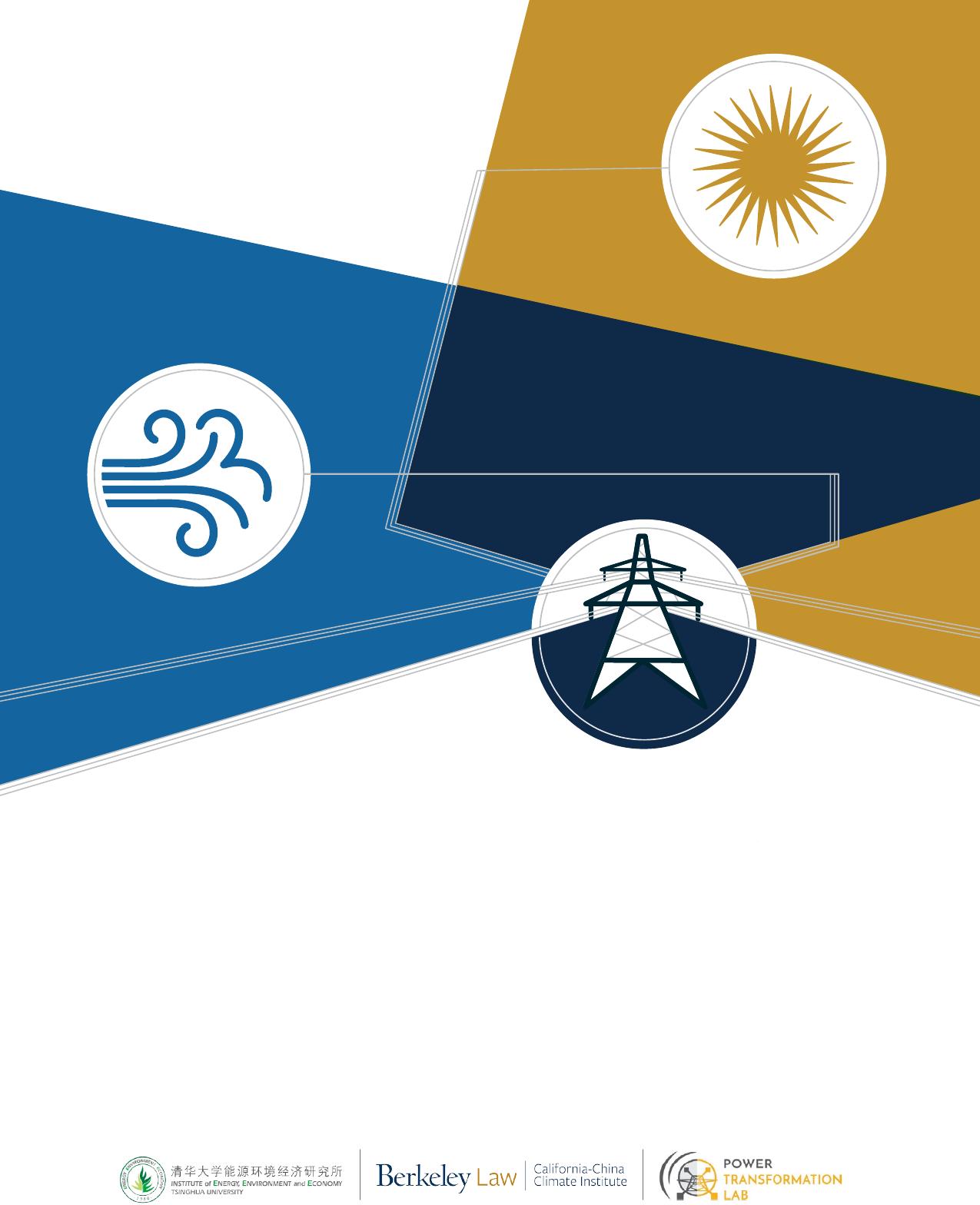RenewableEnergyPathwaystoCarbonNeutralityinChinaMay2023AuthorsZhenhuaZhang1,ZihengZhu2,JessicaA.Gordon3,XiLu4,DaZhang2,andMichaelR.Davidson1,51DepartmentofMechanicalandAerospaceEngineering,UniversityofCalifornia,SanDiego2InstituteofEnergy,EnvironmentandEconomy,TsinghuaUniversity3California-ChinaClimateInstitute,UniversityofCalifornia,Berkeley4SchoolofEnvironmentandStateKeyJointLaboratoryofEnvironmentSimulationandPollutionControl,TsinghuaUniversity5SchoolofGlobalPolicyandStrategy,UniversityofCalifornia,SanDiegoAbouttheCalifornia-ChinaClimateInstitute:TheCalifornia-ChinaClimateInstitutewaslaunchedinSeptember2019andisaUniversityofCalifornia-wideinitiativehousedjointlyatUCBerkeley’sSchoolofLaw(throughitsCenterforLaw,Energy,andtheEnvironment)andtheRausserCollegeofNaturalResources.ItischairedbyJerryBrown,formerGovernoroftheStateofCalifornia,andvice-chairedbytheformerChairoftheCaliforniaAirResourcesBoardMaryNichols.TheInstitutealsoworkscloselywithotherUniversityofCaliforniacampuses,departments,andleaders.Throughjointresearch,training,anddialogueinandbetweenCaliforniaandChina,theInstituteinformspolicymakers,fosterscooperationandpartnership,anddrivesclimatesolutionsatalllevels.AboutthePowerTransformationLab:ThePowerTransformationLabattheUniversityofCalifornia,SanDiegostudiestheengineeringandinstitutionalrequirementstodeploylow-carbonenergyatscale.Weworkwithacademic,government,civilsociety,andindustrypartnerstoadvanceresearchandsolutionstotheclimatechallengecenteringontheroleofthepowergrid.Ourareasoffocusincluderenewableenergyresourceplanning,affordableandreliablelow-carbonpowermarkets,andthepoliticaleconomyofindustrialpolicyandlow-carbontransitionsinfirms.AbouttheInstituteofEnergy,EnvironmentandEconomy,TsinghuaUniversity(3E):TheInstituteofEnergy,EnvironmentandEconomy,TsinghuaUniversity(3E),establishedin1980,isaninterdisciplinaryresearchandeducationinstituteatTsinghuaUniversity.Theinstitute’smissionistocreate,developanddisseminatetheknowledge,ideas,andmethodologiescrucialforbuildingsustainableenergysystemsandmitigatingclimatechangeforChinaandtheworld.AsanimportantthinktankforChina’senergyandclimatechangeresearch,theinstitutehasbeencontinuouslyprovidingpolicyadvisoryservicestotheNationalDevelopmentandReformCommission(NDRC),theMinistryofEcologyandEnvironment(MEE),andtheNationalEnergyAdministration(NEA).Theinstitutehaslong-timecollaborationswithprestigiousuniversitiesandinternationalorganizations.Acknowledgments:TheauthorswouldliketothankChiGao(RegulatoryAssistanceProject)forprovidingresearchassistance,andthefollowingreviewersforhelpfulcomments:FredrichKahrl(California-ChinaClimateInstituteResearchAffiliate),BobWeisenmiller(California-ChinaClimateInstituteResearchAffiliate),JiangLin(LawrenceBerkeleyNationalLaboratoryNatSimonsPresidentialChairinChinaEnergyPolicyandUCBerkeleyAdjunctProfessor),HongyuZhang(TsinghuaUniversityPostdoctoralResearcher),RixinZhu(California-ChinaClimateInstituteMethaneFellow),andFanDai(California-ChinaClimateInstituteDirector).1TABLEOFCONTENTSSummaryforPolicymakers.............................................................................................................................................31.Introduction.......................................................................................................................................................................62.RenewableEnergyTrendsandPolicy.................................................................................................................73.Methods................................................................................................................................................................................94.KeyFindings......................................................................................................................................................................124.1.Increasingrenewableenergydeploymentrates....................................................................124.2.Regionaldistributionsovertime......................................................................................................144.3.Expandedinter-regionaltransmissionconnections............................................................174.4.Morebindinglanduseconstraints.................................................................................................194.5.Misalignmentbetweencoalretirementandrenewabledeployment........................215.PolicyRecommendations.........................................................................................................................................225.1.Acceleratedbuildoutandintegratedplanningprocesses................................................235.2.Deploymentlimitsandsupplychainconstraints...................................................................245.3.Landuseimpactsofrenewabledeployment............................................................................245.4.Politicaleconomyoftransmissionexpansionandcoalretirement............................255.5.Electricitymarketreforms..................................................................................................................266.Conclusion.........................................................................................................................................................................277.References.........................................................................................................................................................................298.Appendix.............................................................................................................................................................................322SUMMARYFORPOLICYMAKERSChinahasannouncedambitiousclimatepolicygoalsofreachingpeakcarbonemissionsby2030andcarbonneutralityby2060.1Toachievethesegoals,itiscrucialtodecarbonizethelargestcarbon-emittingsource,thepowersector,whichfurtherenablestheelectrificationofothersectorssuchastransportation,industry,andbuildings.Thisprocessrequiresalargeincreaseinlow-carbonrenewableenergyandcomplementaryinfrastructure,includingstorageandtransmission.Whiletheselong-termobjectivesareclear,thedeploymentstructure,pace,anddistributionalimpactsareuncertain.Toaddressthisgap,wedevelopedanovelmodelingapproachwithahighspatialandtemporalresolutiontoidentifyfeasibleandefficientpathwaysfordeployingrenewables,storagesystems,andtransmissionlines,bydecade,from2020to2060.2Fromapolicy-makingperspective,understandinglow-carbonpathwaysprovidesnationalandsubnationalgovernmentsinformationneededtoanticipate,planfor,andaddressawiderangeofbottlenecksthatwillarisewiththisunprecedentedtransformation.Ouranalysishelpssupportamoreeffective,efficient,andequitablecleanenergytransitionforChina.SPMTable1DeploymentPrioritiesAcrossDecadesUtility-scaleDistributedOnshoreOffshoreStorageTransmissionwindlinessolarsolarwindDeployinhigh-variableExpandthree2020-Deployinhigh-qualityDeployEnsurerenewableregional2030regionsinthenorthandwestindeploymentenergyregionsclustersnortherneffortsaretomanage(northwest,2030-Extendtomajorloadcentersregionssufficientdiurnalsouth,and2040drivenbycontinuousandindrivingvariationsnorth)renewablecostdeclinescoastaldowncostsregionsinspiteofPrioritizeStrengthenunfavorablebatterymajoreconomicsstorageinnorth-southregionswithcorridors2040-LargelyPrioritizePrioritizeRampuplimitedhydrothroughboth2050exploitthecoastalcoal-richdeploymentresourcecentralandavailablelandregionsregionsinincoastalavailabilityeasternregions2050-nearmajorduetothenorthtoregionsduewhile2060loadcentersproximitycoordinatetorapidcostpromotingExpandbothandcontinuetoloadwiththedeclinesfurtherinterprovincialtheexpansioncentersphasedownbatterycostnetworksandinnortherndrivenofcoaldeclineslong-distanceandwesternbylowerplantsnationalregionsduetransmissionnetworkstotoincreasingandaccommodatelanduseintegrationrenewableandcoalcostsintegrationsphasedown1UnitedNations,20202Zhangetal.,UnderReview3EnergyTransition:StructureandPaceTheannualcapacityadditionsofwindandsolarwillneedtoincreasefromaround70gigawatts(GW)peryearinthefirstdecade(2020-2030)to210-300GWperyearinthelastdecadebeforeitscarbonneutralitygoal(2050-2060),whiletotalinstalledcapacitiesreach2100-3200GWby2040,3300-4800GWby2050,and5200-5300GWby2060.Integratingthesevariableenergyresourcesintothegridrequiresstorageandtransmissionlinestoaddressinter-regionalimbalancesandinter-temporalvariations.Annualstorageadditionsincreasefrom105-173gigawatthours(GWh)peryearinthefirstdecadeto180-260GWhperyearinthelastdecade,whilethetransmissionnetworkexpandsatratesof13-16GW/year(2020-2030),13-38GW/year(2030-2040),18-24GW/year(2040-2050),and5-35GW/year(2050-2060).Historicalratesofmanufacturingcapabilitiesarelikelytobesufficienttomeetdomesticdemand,thoughcruciallydependingonthescaleofcleanenergytechnologyexports.GeographicDistributionThegeographicaldistributionsofdifferenttechnologiesoverfourdecadesarehighlightedinSummaryForPolicymakers(SPM)Table1.Ourresultsdemonstrate,underfeasibleandefficientpathways,thatutility-scaleanddistributedsolarwillstartinthenorthandwestregionsofthecountryduetohighercapacityfactors,andthenextendtomajordemandcentersstartingfromthenextdecade(2030-2040).Thisshiftislargelydrivenbyrenewablecostdeclinesandhightransmissioncosts.Notably,distributedsolarwillbemoreprominentalongthecoastsincethecostswillbecomesimilartowesternregionsovertime.Inaddition,onshorewindhasawidefootprintbothinnorthernChinaandalongthecoast,whilecontinuouscostdeclineswillincentivizethedeploymentofoffshorewindincoastalprovinces.Relativelyhightransmissioncostsdriverenewabledeploymentinlower-qualityregionssuchaseasternChina,butlow-coststoragealtersthisdynamicbyallowingrenewabledeploymentinhigh-qualityregionssuchasnorthernChinainlaterdecades.Thissuggeststhatregionalprioritizationsandrenewabletargetsattheprovinciallevelwillbevaluableforguidinglocalgovernmentsandsustainingthecurrentdeploymentmomentum.LandUse,EconomicImpacts,andElectricityMarketChallengesSolardeploymentwillexhaustthemajority(51-82%)ofsuitablelandineasternprovincesby2060,whilewindwillsignificantlyimpactcoastalprovincelands(14-48%),drivenbypromisingrenewableenergypotentialsandproximitytodemand.Whilefurtherguidanceonsitingandpermittingfromthenationalgovernmentisneeded,localgovernmentsshouldestablishprojectpathwaysandregionalstandardsforco-locationusestoreduceprojectuncertaintiesandmitigatelanduseimpacts.Furthermore,asthetransmissionnetworkbecomesmoreinterconnected,thetotaltradingvolumewilllikelyseeathree-foldincreaseby2060.Efficientinner-andinter-regionaltradingmechanismsarethusessentialinintegratingrenewablesandreducingsystemcosts.PolicyRecommendationsNationalandsubnationalgovernmentshaveastrongroletoplayinachievingChina’scleanenergytransition.Toaddresslargechallengesanduncertainties,weidentifynear-andlong-termprioritiestodesignandimplementsupportingpolicyprogramstoensuregoalsaremetovertime.TherecommendationsarehighlightedinSPMTable2.4SPMTable2PolicyRecommendationsNear-termNationalGovernmentProvincialGovernments(2020-2035)•Incorporateandenforceclear•Promoteretailandwholesalemarketdeploymenttargetsorportfolioreforms(e.g.,time-of-usepricing,standardsintheupcomingfive-yearspotmarkettrading)toimproveplansforrenewableenergyrenewableprojecteconomics•Integratestorageandtransmissions•Identifystrategiestofacilitateintotherenewableplanningprocessescoalretirementandmitigatelocalwithspecificdeploymenttargetsfinancialandsocialimpacts•SetstandardsforregionalelectricitymarketstoallowmoreefficientpowertradingandbalancingLong-term•Providenationalguidanceonrenewable•Monitorglobalmarketsforwind(2035-2060)sitingandpermittingprocessesandsolarequipmenttoensureasufficientsupplytomeetdeployment•Developpropercompensationtargetsmechanismsmainlyforflexibleconventionalresources,andensure•Establishprojectpathwaysandcontinuouscostdeclinesofrenewablesregionalstandardsoninstallingviaauctionsrenewablesonagriculturallands•Strengtheneffectivecompensationmechanismstofacilitatetheleast-costdeploymentoptionsfordistributedenergyresources51.INTRODUCTIONChinaistheworld’slargestgreenhousegas(GHG)emitterandhasannouncedambitiousclimatepolicygoalsofreachingpeakcarbonemissionsby2030andcarbonneutralityby2060.3Toachievethesegoals,itiscrucialtodecarbonizethelargestcarbon-emittingsource,thepowersector,whichfurtherenablestheelectrificationofothersectorssuchastransportation,industry,andbuilding.Asmostofthecarbonemissionsfromthepowersectorcomefromburningcoalandnaturalgas,replacingcarbon-intensivefossilfuelswithlow-carbonrenewableenergyandcomplementaryinfrastructureiskeytodecarbonizingthepowersector.Despitetheseclearlong-termdirections,thereisuncertaintyaboutthepace,structure,anddistributionalimpactsofthetransitiontoanet-zerofuture.Thepaceindicateshowquicklyweshouldreducecarbonemissionsandreplacefossilfuelswithrenewables,whilethestructurereferstowhichtechnologiesaredeployedovertimeandinwhichregions.Fossilfuelretirementandthedeploymentofrenewables,transmission,andstorageaffecthowcostsandbenefitswillbedistributedacrossregionsandinterestgroups,whichinturnalterthefeasibilityandequityofvariouspathwaystocarbonneutrality.ThisstudyseekstouncoverfeasibleandefficientpathwaystocarbonneutralityforChina’spowersectorwithsufficientgranularitytoassesstheuncertaintiesofrenewabledeploymentrates,geographicaldistributions,andlanduses.SeveralstudieshaveexaminedChina’spowersectorassnapshotsinfutureyears,e.g.,powersystemoptimizationmodelsofrenewableenergydeploymentandtransmissionexpansionin2030,42050,5,6and2060.7Snapshotanalysesareusefultospecifyanoptimalend-state,buttheydonotconsiderpotentialunevendistributionsandbottlenecksofrenewableandtransmissionbuildoutacrosstime.Incomparison,studiesusingintegratedassessmentmodelsidentifypathwaystodeepdecarbonizationbyaroundmid-century,butlackspatialresolutionandgridoperationaldetailstoexplorelocalizedimpactsofthetransition.8,9Asregionshavedifferentexistingfossilfuelcapacitiesandwilldeployrenewableenergyatdifferentrates,thetransitionawayfromfossilfuelswillnotaffectallregionsequallyandovertime.Similarly,ifregionsonlyseehugerenewableadditionsinlaterperiods,theymightnothavetheinstitutionalcapacityinplacetodeployandintegraterenewableenergyintothegridwhilemeetinggridreliabilityrequirements.Furthermore,periodsofrapidexpansionofinfrastructuremustbeabletobemetviamanufacturingandprojectdevelopmentcapacity,andcouldhaveimportantimplicationsforlanduse.Inthisstudy,weaimtobridgethisgapbycalculatingsequentialpathwaystocarbonneutralityforChina’spowersectorfrom2020to2060withdecadalresolution.Fromapolicy-makingperspective,understandingpotentiallow-carbonpathwaysprovidesnationalandsubnationalgovernmentstheinformationneededtoanticipate,planfor,andaddressawiderangeofconstraintsthatwillarisewiththisunprecedentedtransformation.Ouranalysishelpssupportamoreeffective,efficient,andequitablecleanenergytransitionforChina.3UnitedNations,20204Heetal.,20205Chenetal.,20216Zhuoetal.,20227Zhangetal.,UnderReview8Duanetal.,20219Heetal.,202262.RENEWABLEENERGYTRENDSANDPOLICYChinaistheworldleaderinrenewableenergydeployment.Asof2022,Chinahasinstalled365gigawatts(GW)ofwindand390GWofsolar,asrecentyearshaveseenunprecedentedratesofnewadditions—40GWofwindand52GWofsolarperyearonaverageforthepastfiveyears.10Theinstalledwindandsolarcapacitiesareprimarilylocatedinthe“threenorth”regionswhiletheeastcoastalsohasagrowingsolarfootprint(Figure1).Thereisafundamentalmismatchbetweensomeofthehigh-qualityresourcesandmajorelectricitydemandcenters,whicharelocatedalongthecoast(e.g.,Shandong,Guangdong,andJiangsu),primarilydrivenbyhighpopulationdensitiesandeconomicdevelopment.Provincesinthenorthandwesthavethebestqualitysolarresourcesduetohighannualirradiations(e.g.,Qinghai,Gansu,andInnerMongolia),whileprovincesinthenorthandalongthecoasthavehigh-qualitywindresources(e.g.,Gansu,InnerMongolia,andJiangsu).Inaddition,windandsolarcapacitiesaremostlyequalineachregion,withtheexceptionsofthenortheastandeast.Figure1InstalledWindandSolarCapacitiesAcrossGridRegionsasof2022Source:ChinaElectricityCouncil,2023.China’srenewableenergygrowthisdrivenbyasetofgovernmentpoliciesfocusingonmanufacturing,increasingadoptionrates,andmarketreforms.11,12The14thFive-YearPlan(2021-2025)(FYP)forRenewableEnergysetsatargettodeployatleast1,200GWofwindandsolarby2030,andpromotesthedevelopmentofcomplementaryinfrastructureincludingstoragesystemsandtransmissionlines.13Toaddresspreviouschallengessuchashighrenewablecurtailments,gridoperationinefficiencies,andgridconnectiondelays,14,15theChinesegovernmentissuedenergymarketreformsin2015,featuringnewmarketparticipationrulesandelectricitypricingmechanisms.1610ChinaElectricityCouncil,202311Guoetal.,202012Nahm,201713NationalDevelopmentandReformCommission,2021a14InternationalEnergyAgency,201815Luetal.,201616StateCouncil,20157Acceleratedrenewabledeploymentwilllikelyintensifyconcernsaroundrenewableintegrationandlanduse.Althoughthe14thFYPsetdeploymenttargetsandregionalfocusesforstorageandtransmission,therehasbeenminimalefforttotranslatetargetstospecificprojectswithspatialgranularity.Project-specificrequirementsareessentialtopreemptivelyremoveinstitutionalbarriers,andensurethatcomplementaryinfrastructurekeepspacewithrenewabledeployment.Furthermore,recentlandusepolicieshaveescalateduncertaintiesinrenewabledeployment.The14thFYPhighlightedtheinstallationofdistributedgenerationonvariouslandusetypes,butprojectimplementationcanfacemorestringentlocalstandardsorinadequateinformation,regardinglanduserestrictionsandclassificationsofpotentialprojectsites.Theseevolvingchallengescandelayrenewabledeploymentandimpactsystemcostsifnotproperlyaddressed.Consideringtheaforementionedpolicygaps,weexploredecadalpathwaysfrom2020tocarbonneutralityin2060withafocusonseveralquestions:(1)Whatstructuresandpacesarerequiredforthedeploymentofrenewables,storage,andtransmission?(2)Whatarethegeographicaldistributionsofdifferenttechnologiesacrossdecades?and(3)Whatarethelanduseimpactsacrossregionsovertime?Theanswerstothesequestionswillhelpstrengthentheunderstandingofimplementationprioritiesbothinthenear-andlong-term,aswellasthesupportingpoliciesthatarerequiredtoachieveChina’sclimatepolicygoals.83.METHODSWedevelopahigh-resolutionpowersystemplanningandoperationmodeltosimulateChina’spowersectorineachdecade.17Themodeloptimizestheamountandlocationofvariablerenewableenergy(VRE),storagesystems,andtransmissionlinesatthelowestcost,whilesatisfyingprovincialhourlyelectricitydemands,gridreliability,andlanduseconstraints,amongotherrequirements,forawholeyearofoperation.Theobjectiveofeachsimulationistominimizethetotalannualizedcostsofinvestmentandgenerationdispatch.Weadaptthismodeltoevolvingpowersystemconditionsandinputassumptionsbysequentiallylinkingtheoutputsofeachdecade.Thecombinedmodeloutputsacrossperiodsidentifyfeasibleandefficientpathwaysforrenewabledeploymentfrom2020to2060(Figure2).FurtherinformationonmodelinginputsandmethodologyisprovidedintheAppendix.ThegeographicresolutionisgivenbyrenewableresourceavailabilitycomputedfromtheGoddardEarthObservingSystemModel(GEOS-5).18GEOS-5provideshourlysimulationdataofatmosphericpropertiesincludingtemperature,windspeeds,andsolarirradianceataspatialresolutionofapproximately31by25kilometerspercell.Weconsiderawiderangeoflandsuitabilityassumptions,suchaspreferencesforlowslopesandaltitudesandforcertainlandtypeswithfewercompetinguses.Forexample,theNationalEnergyAdministrationandotherministrieshaveissuedlanduseregulationsthatrestrictsolardeploymentonproductiveagriculturallands,whereweassumeonlyasmallfraction(2-20%)isavailableforsolar,whilewindcanbedeployedonmost(80-100%)ofthecroplands,grasslands,shrublands,andbarrenlands.19Table1ModelScenarioDescriptionsRenewablecostCoalretirementScenarionameDescriptionevolutionscheduleBaselineEmissiontargetsarebasedontheTsinghuaOptimisticNormalICCSD2ºCscenario.MoreoptimisticcostConservativedeclinesinrenewableenergy.CoalplantsConservativeNormalCostDeclineshave40yearsoflifespan,andCCSretrofitsstartin2030.OptimisticAcceleratedAcceleratedCoalRetirementMoreconservativecostdeclinesinthecapitalcostsofrenewableenergy,consistentwithpercentagedecreasesfromNRELAnnualTechnologyBaseline.Acceleratedcoalretirementscheduleassumingmorestringentpolicytargetsareenforced.Coalplantshave30yearsoflifespan,andCCSretrofitsstartin2040.ThemodelconsidersfourtypesofVREtechnologies(i.e.,onshorewind,offshorewind,utility-scalesolar,distributedsolar),twotypesofstoragesystems(i.e.,pumpedhydrostorage,batterystorage),andthreetypesoftransmissionlines(i.e.,spurlines,trunklines,andinter-provinciallines).Spurlinesandtrunklinesconnectwindandsolartothehigh-voltagegridandarefactored17Zhangetal.,UnderReview18NASA,201019NationalEnergyAdministration,20179Figure2ModelingFrameworkforDecarbonizationPathwaysofChina’sPowerSectorThemodelingframeworkinpanel(a)includesmodelparameters,constraints,objectives,andoutputs.Panel(b)showstheoutputs-inputslinkagebetweensequentialsnapshots.Exogenousparametersarefedintoeachmodelrun,andmodeloutputsofonerunareusedasinputsforthenextrun.intothecostsofdeploymentpercell.Provincialinvestmentsandhourlygenerationdispatchdecisionsandinter-provincialelectricitytransfersareobtainedfromthesimulationoutputs.Eachmodelrunincludesexogenousparametersobtainedfromrelevantmodelingstudiesandpolicydocuments.Wefixthefirmresourcecapacitiesineachdecadeaccordingtovariousgrowthassumptionsandrestrictfossilfuelemissionstobeconsistentwitha2ºCglobalaveragetemperaturerisetarget.20Wefurtherletpowerbecomeanetemissionsinkwith550milliontonsofnegativecarbonemissionsin2060tooffsetemissionsfromothersectors.Inaddition,weallowcarboncaptureandsequestration(CCS)fornaturalgasandcoalpowerplantstoreducecarbonintensity,consideringpartialcapturerates.Wedesignthreescenariosoftheevolutionofrenewablecostsandtheretirementscheduleofcoalplants(Table1)toevaluatetherobustnessofourfindings.IntheBaselineScenario,weadoptanoptimisticcostdeclinetrajectoryrelativetothe2020levelforthecapitalcostsandoperationcostsofwind,solar,andstorageinthecontextoftheChinesemarket.IntheConservativeCostDeclinesScenario,weassumethatthecapitalcostsofwind,solar,andstoragehaveslowerpricedeclinescomparedtothebaselinescenario,basedontechnology-specific20TsinghuaUniversity,202010projectionsfromtheU.S.NationalRenewableEnergyLaboratory.21IntheAcceleratedCoalRetirementScenario,weassumethatmorestringentpolicyframeworkswillbeimplementedtofacilitatetheretirementofcoalplants.22Underthisscenario,coalplantsareexpectedtohave30yearsoflifespaninsteadof40yearsunderthebaseline,andcoalretrofittingforCCSonlystartsafter2040comparedto2030underthebaseline.Acrossallthreescenarios,weenforceaminimum1,200GWrenewabledeploymenttargetby2030tobeconsistentwiththecurrentrenewableenergypolicyprograms.21NREL,201722Cuietal.,2022114.KEYFINDINGS4.1.Increasingrenewableenergydeploymentrates•Significantamountsofrenewableenergyandstoragewilldriveacleanerpowergenerationmixovertime.•Increasingdeploymentratesareneededtomeetthenecessaryinstalledcapacitiesineachdecade.•Inordertoacceleratecoalretirement,afasterrenewabledeploymentpaceisrequired.•Giventhehistoricallyhighratesofmanufacturing,existingcapacityislikelytobesufficienttomeetrenewableenergyproductiondemand.Ourresultsshowthatasignificantamountofwind,solar,andstoragewillbedeployedinChinaacrossalldecadesunderallthescenarios.Figure3(a)showsnationwideinstalledcapacitiesacrossscenarios.IntheBaselineScenario,windcapacityincreasesfrom583to2201GW,andsolarcapacityincreasesfrom615to3174GWfrom2030to2060.Storagecapacity,coveringboth8-hourpumpedhydroand4-hourbatterystorage,increasesfour-foldfrom1397to5930gigawatthours(GWh)from2030to2060.Bycomparison,theConservativeCostDeclinesScenariohassimilarinstalledrenewableandstoragecapacities,buttherelativesharesofrenewabletechnologieschange—inparticular,distributedsolarandonshorewindseehigherinstallations.TheAcceleratedCoalRetirementScenariodeploysanadditional1052GWofrenewablesand1948GWhofstorageby2040,andanadditional1303GWofrenewablesand2375GWhofstorageby2050ascomparedtothebaseline,drivenbyastrongerneedtoreplacetheretiredcoalcapacityduringthesetwodecades.Amongstoragetechnologies,batterystorageisneededsoonerintheAcceleratedCoalRetirementScenariothanthebaseline,assomeregionsrunintotheassumedlimitsonpumpedhydroresourcesandneedtousebatterystorageasanalternative.Duetoincreasingrenewablepenetrationrates,fossilfuelplaysalessimportantroleinChina’spowersector.Figure3(b)showsthenationwidegenerationmixacrossscenarios.IntheBaselineScenario,theshareoffossilfuelsinthegenerationmixdropsfrom51%in2030to35%in2040,19%in2050,and8%in2060.Bycomparison,theshareofwindandsolargenerationincreasesfrom27%in2030to39%in2040,49%in2050,and56%in2060.TheConservativeCostDeclinesScenarioseesasimilargenerationmixtothebaseline,whiletheAcceleratedCoalRetirementScenarioimpliesamoreimportantroleofrenewableenergyinthegenerationmix.Theseconclusionsareroughlyinlinewithpreviousstudies,23,24,25butprovidedecadalresolutionstothestructureandpacerequiredforthetransition.Toreachtheinstalledrenewablecapacitiesineachdecade,ourresultsshowthatthecombinedrateofcapacityadditionsforwindandsolarwillneedtoincreasefrom70GWperyearinthefirstdecadeto210-300GWperyearinthelastdecadeacrossscenarios,assumingthatallexistingVREcapacityin2020willretireby2045andthenewlybuiltVREhasalifespanof25years.Ontheotherhand,historicalratesofrenewablecapacityadditionsexceednear-termrequirements.Thepastfiveyearshaveseenanaveragerenewabledeploymentrateof92GW23Chenetal.,202124Khannaetal.,202125Zhuoetal.,202212Figure3NationwideInstalledRenewableCapacitiesandGenerationMixfrom2030to2060peryear(40GWperyearforwindand52GWperyearforsolar).26Furthermore,onthesupplyside,manufacturingcapacitiesforwindturbinesandsolarmoduleswereestimatedtobe80GWand264GWperyearin2022,respectively,sufficientforhandlingdomesticdemands,thoughwedonotmodelexpectedexportdemands.27,28Moreover,tomeetthestoragedeploymenttargets,ourresultsshowthattherateofstoragecapacityadditionswillneedtoincreasefrom105-173GWhperyearinthefirstperiodto180-260GWhperyearinthelastperiodacrossscenarios,assumingthatthestoragesystemhasalifespanof15years.However,historicalratesofstoragecapacityadditions,includingbothpumpedhydroandbatterystorage,wereonlyaround50GWhin2021.29,30Onthesupplyside,China’smanufacturingcapacityforstationarybatterystoragesystemswas130GWhperyearin2022,approximately10%ofthetotalbatterymanufacturingcapacity.31Assumingthatmanufacturingcapacityforpumpedhydroissufficient,meetinglong-termstoragedemandswilllikelybeplausibleacrossperiods.26ChinaElectricityCouncil,202327InternationalEnergyAgency,2022b28WoodMackenzie,202229EnergyInformationAdministration,202230InternationalEnergyAgency,2022a31WoodMackenzie,202213Figure4Provincial-levelInstalledSolarandWindCapacitiesfrom2030to20604.2.Regionaldistributionsovertime•Underfeasibleandefficientpathways,utility-scaleanddistributedsolarwillexpandfromthenorthandwesttomajordemandcentersstartinginthe2030s.•Distributedsolarwillincreasealongthecoast,duetolowertransmissionandintegrationcosts.•Onshorewindwillexpandinthenorthandalongthecoast,whilecontinuouscostdeclineswillpromotethedeploymentofoffshorewindincoastalprovinces.•Storagedeploymentismainlycorrelatedwithprovincialrenewablecapacities,inparticular,solarcapacity.Totalrenewableinstallationsareprimarilydrivenbyrisingdemand,coalretirement,andtheavailabilityofotherfirmresources,andaredependentoncomplementarystorageandtransmissionexpansionineachdecade.Regionswithlowdemandandhighresourcequality,suchasthewestandnorth,haverenewabledeploymentandtransmissionexpansionduetotheneedtoexportpower.However,thisneedcanbeoffsetbytheincreasingrenewabledeploymentinimportingregionsdrivenbycostdeclines.Figure4showstheprovincial-levelinstalledVREcapacitiesfrom2030-2060,andFigure5offersadetailedperspectiveatthecelllevel.Inthefirstperiod(2020-2030),ourresultsindicatethatVREwillbedeployedinregionswithhighcapacityfactors(CF)andthuslow14Figure5Cell-levelInstalledSolarandWindCapacitiesfrom2030to2060(a)SolarCapacity(b)WindCapacityNote:Windincludesbothonshoreandoffshorewind,andsolarincludesbothutility-scaleanddistributedsolar.levelizedcostofelectricity(LCOE)fromaleastsystemcostperspective.CFmeasurestheactualpowergenerationasafractionofthetotaltheoreticalpotentialgenerationatmaximumoutput,andLCOEmeasuresthediscountrate-adjustedcostperunitofproductionoverthelifetimeoftheplant.Utility-scalesolaranddistributedsolarwillbemoreconcentratedinthewestandnorth,whileonshorewindwillbedeployedinbothnorthernregionsandmajorload15Figure6ProvincialGenerationCapacitiesfrom2030to2060centersalongthecoast,inlinewithpreviousresearchthathasexaminedearlydeploymenttrends.32Furthermore,resultsshowthatalimitedamountofoffshorewindwillbebuiltduringthe2020sduetoitsassumedhighcapitalcostsrelativetoothertechnologytypes.Thesecondperiod(2030-2040)seestheVREdeploymentextendtolower-CFregionsduetodecliningrenewablecostsandrelativelyhightransmissionexpansioncosts.Utility-scalesolaranddistributedsolarcontinuetospreadtomajorloadcenters,whilewinddeploymentcontinuesitsprevioustrendsinthisdecade.Inthethirdperiod(2040-2050),continuousrenewablecostdeclineswilldrivedeploymentinlow-CFregions,butlow-coststoragesystemswillalterthisdynamicbyallowingmoreeconomicdevelopmentinhigh-CFregionsfacinghigher32Heetal.,202016integrationbarriers.DistributedsolarwillhavestrongerprominenceinregionsalongthecoastinlaterperiodsdespitehavinglowerCFs,duetolowertransmissionandintegrationcostsoflocatingclosetodemand.Utility-scalesolarandonshorewindwillhavealargefootprintinbothmajorloadcentersandlessland-constrainedregionsinthenorthandwest.Overall,wecanobservefewerregionaldisparitiesinsolardeployment.Thelastperiod(2050-2060)seesasignificantramp-upinoffshorewinddeploymentalongthecoastduetorapidcostdeclines.Othersnapshotstudiesfocusingonlaterperiodsfindsimilarregionaldistributionsby2050or2060,33,34whilethisstudypresentstheevolvingdynamicsovertimeandexplainshowwewilllikelyreachtheseoutcomes.Usingprovincialresultsasanexample,wecanseethatmajordemandcentershaverenewabledeploymentprimarilyinlaterperiods,whilehigh-qualityregionsseedeploymentacrossdecades.Forexample,Henan,oneofthemajordemandcenters,willonlyhave9GWofutility-scalesolarinthefirstperiod(2020-2030)ascomparedtoInnerMongolia’s52GWandYunnan’s50GW.However,Henanstartsacceleratinginthethirdperiod(2040-2050)andeventuallyhas180GWofutility-scalesolarby2060.Anothermajordemandcenter,Jiangsu,willdevelop30GWofonshorewindby2030,andreach262GWby2060.InnerMongolia,aprovincewithhigh-qualitywindresourcesandsignificantdeploymenttodaywillseelargeonshorewindinstallationacrossalldecadeswith79GWby2030and299GWby2060.Figure6showstheprovincial-levelgenerationcapacitiesforallgenerationtechnologies.Ourresultsshowthatamajorityofprovinceswillhavetotalgenerationcapacitiesfarexceedingtheirpeakdemands,acommonoccurrenceduetothelimitedandvaryingrenewableenergycapacityfactors.Someprovinceswithlimitedrenewableavailabilityandahighdependencyonelectricityimports,suchasHunan,willhavetotalgenerationcapacitiesbelowpeakdemandlevelsinalllaterdecades.Storagedeploymentismainlycorrelatedwithrenewablecapacitiesineachprovince,inparticular,solarcapacity.Asmentionedearlier,storagesystemsplayanincreasinglyimportantroleinbalancingthediurnalvariationsofVREresources,andcontinuousstoragecostdeclinesallowmoreeconomicdevelopmentinhigh-CFregions.Ifregionshavenetelectricityexportsdrivenbyexcessrenewablecapacity,storagecapacitywilllikelybesubstitutedbytransmissionlinesforpowerbalancing.Throughcomparingstoragetechnologytypes,wecanobservethatpumpedhydrostorageisdeployedinhigh-VREregionsatearlystages,butcanreachtheassumedmaximumdeploymentpotentialinregionswithlimitedresourceavailabilityinlaterperiods.Bycomparison,ourresultsshowthatbatterycapacityismostlyneededinthelatterstagesofdecarbonization.Thesefindingsaredrivenbytheassumptionsthatbatterystoragestillhashighearly-stagecapitalcostsrelativetopumpedhydrostorage,andthevalueofstorageprimarilystemsfrommeetingresourceadequacyrequirementsandsmoothingoutVREgeneration.Wedonotexplicitlymodeltechnologicallearning,andthereforestillconcludethatsomeearlybatterystoragedeploymenteffortsareessentialtocontinuecostdeclines.4.3.Expandedinter-regionaltransmissionconnections•Thetransmissionnetworkwillexpandtonewregionsandtradingvolumeswillrisetoaccommodaterenewableintegration.•Increasingtransmissionexpansionrateswillberequiredinthelongterm.Ourresultsindicatethattransmissionnetworkexpansionwillexperienceregionalshiftsacrosstimeperiods.Figure7showsthenewlyaddedtransmissioncapacitiesfrom2020-2060,whileFigure8displaystheirgeographicaldistributions.Duringthefirstdecade,interprovincialconnectionswillbestrengthenedinthreeregionalclusters—northwest,south,andnorth.Newtransmissionlinesmostlyconnectlow-demand/high-firmcapacityregionstohigh-demand/low-firmcapacityregions.Startingfromthe2030s,majornorth-southcorridorswillbeexpandedtoconnectcentralandeasternregionswithotherregions.Thisshiftismostly33Chenetal.,202134Zhuoetal.,202217Figure7NewlyAddedTransmissionCapacityfrom2020to2060becauseitwillstillbemoreeconomicaltodeployrenewablesandtransmissionlinesinhigher-qualityregions.Duringthelasttwodecades,transmissionnetworkswillbeexpandedacrossChinaduetorapidrenewabledeploymentandcoalphasedowninallregions.Acceleratingcoalretirementcanspeedupthetransmissionexpansiontoearlierstagestocomplementtherenewablebuildout.Overall,totalnationwideexpansionratesofinter-provincialtransmissioncapacityare13-16,13-38,18-24,and5-35GWperyearacrossdecades,includingbothhigh-voltageandultra-high-voltagelines.Consideringthatthepastdecadehasseenultra-high-voltagelinesexpandatarateofapproximately16-20GWperyear,meetingthenear-termtransmissionexpansionrequirementsshouldbeplausible.35Resultsfurthershowthattotalnationwidepowerflowswillincreasefrom2.1petawatthour(PWh)in2030to6.4PWhin2060.Theshareofpowerthatflowsinbothdirections,willincreasefrom8.2%to8.8%,12.2%,and19.8%overthedecades.Onaregionallevel,thenetexportedamountfrommajorexporters(northwest,northeast,andsouth)willincreasefrom527TWhin2030to1455TWhin2060,suggestingthatregionswillbemoreinterdependent.Asourmodelassumesthatprovincescantradepowerfreelyuptototaltransmissioninterconnectioncapacities,neglectingoperationalandmarketfrictions,thetotaltradedvolumemaybeoverestimated.35ChinaPower,202218Figure8GeographicalDistributionsofNewlyAddedTransmissionCapacityfrom2020to2060Tradeoffsbetweenlanduseandtransmissionexpansionalsooccur.First,eventhoughthelandisnotexhaustedincoastalregionsatearlystages,itismoreeconomicaltousehigh-qualityresourcesinthenorthandwestduetotherelativelylargerregionaldifferencesinLCOEs.Thus,astheresultssuggest,transmissionlineswillbebuiltintheearlystagestofacilitatelong-distancepowerbalancing.Asthecostsofrenewablesfurtherdecline,coastalregionswillrampuprenewabledeployment,whichpartiallyoffsetstheneedforfurthertransmissionexpansion.Second,inlaterstageswhenthelandissignificantlyexhaustedincoastalregions,itwillnotbeeconomicaltouselow-CFandhigh-LCOEcellsforfurtherdeployment.Consequently,wecanobservestabilizedorslowerrenewabledeploymentpacesinsomeofthecoastalregionsbutwithmoretransmissionexpansion.4.4.Morebindinglanduseconstraints•Large-scalesolarandwinddeploymentislandintensive,causingincreasinglybindinglanduseconstraintsonlow-carbongoals.•Solardeploymentwillexperienceashiftinmostimpactedregionsfromthewestandnorthtoeasternprovinces,whilewinddeploymentincurslandusepressuremostprominentlyincoastalprovinces.Aswindrequireslesslanduseperunitcapacityandcanbedeployedonmoretypesofland(includingagriculturalland),thedeploymentofwindhassmallerlanduseimpactsthanthatofsolar.Figure9showsthefractionofsuitablelandforeachrenewableenergytypethatisutilizedfrom2030-2060.Solardeploymenthasanaverageusageof11%,19%,24%,and32%ofsuitablelandinthenationfrom2030to2060,meaningthatby2060,roughlyone-thirdofthelandthatissuitableforsolarhasinstalledsolar.Themostimpactedregionsswitchfromthe19Figure9PercentageSharesofSuitableLandforWindandSolarfrom2030to2060(a)Suitablelandforsolar(b)SuitablelandforwindNote:Windincludesbothonshoreandoffshorewind,andsolarincludesbothutility-scaleanddistributedsolar.westandnorthinthefirstdecade(21-24%)totheeasternprovincesstartingfromtheseconddecade(30-72%).Inthelastdecade(2050-2060),themajority(51-82%)ofsuitablelandforsolarineasternprovinceswillbeexploited.Bycomparison,winddeploymentimpactslandusetoalesserextentthansolar,andmostlyincoastalprovinces.Thelastdecadewillsee14-48%ofsuitablelandexhaustedforwindfarms.204.5.Misalignmentbetweencoalretirementandrenewabledeployment•Inmostprovinces,additionalrenewablecapacitywillexceedretiredcoalpowercapacityovertime.•However,therearestillpossiblemisalignmentsbetweenrenewabledeploymentandcoalretirementinregionswithearlyordelayedbuildouts,indicatingpotentialpoliticaleconomychallenges.Coalretirementandrenewableenergydeploymentproceedatdifferentspeedsacrossprovinces.Ifregionshaveearlyordelayedrenewablebuildouts,therewillbeamisalignmentbetweencoalretirementandrenewabledeployment.Ascoalplantsbegintoretireinlargernumbers,thesecanbeassociatedwithfinancialandsocialrisks(e.g.,strandedassets,joblosses)withoutsufficientcomplementarypolicysupport.Inourresults,northeasternprovinceswillhavepredominantlyearly-stagerenewabledeployment,leadingtoa4.8GWdifferenceinretiredcoalandinstalledrenewablecapacitiesinthelastdecade.Similarly,centralprovinceswillstartdeployingrenewableinlaterstagesandthuscanseeagapofupto8.7GWinthefirstdecades.Otherregions,incomparison,willseerenewableadditionsexceedtheretiredcoalcapacityacrossdecades.Overall,maximumcoalretirementratesonaprovinciallevelcanincreasefrom3.9GWperdecadeinthefirstperiodto9.1,38.4,and61.1GWperdecadeinlaterperiods.Thisrequiresgreatereffortsincoordinatingcoalretirementandrenewabledeployment,withafocusoncoal-richandlow-renewablepotentialregionstoreducelocaloppositionduringtheimplementationofcoalretirementprograms.Forinstance,inShanxi,therehasbeenpersistentresistancetocoalretirementduetolackofassistanceprograms,ascoal-relatedindustriescontributesignificantlytoemploymentandlocalgovernmentrevenues.Inthecaseofmorestringentpolicytargetsaccompaniedbyacceleratedcoalretirement,themisalignmentwilllikelybemoreexacerbatedinregionswithdelayedbuildoutswhererenewableeconomicsarelessfavorableinearlyperiods.215.POLICYRECOMMENDATIONSThisreportpresentedpathwaystocarbonneutralityforChina’spowersectorfrom2020to2060.Table2highlightsthedeploymentprioritiesbytechnologytypeacrossdecadesbasedonoursimulationresults.Byexaminingthetemporaldeploymenttrendsandlocalizedimpactsacrossregions,weidentifypolicyrecommendationsinthenear-termandlong-termonbothnationalandsubnationallevels,asshowninTable3.Designingandimplementingthesepoliciesrequiresgreatercoordinationbetweenthenationalandsubnationalgovernments,duetotheneedtoaddressemerginglocalissuesandensureequityacrossregions.ThesepolicyeffortswillnotonlyconsolidateChina’sleadingroleintherenewableenergysector,butcanserveasablueprintforotherdevelopingeconomiestotransitionawayfromfossilfuels.Table2DeploymentPrioritiesAcrossDecadesUtility-scaleDistributedOnshoreOffshoreStorageTransmissionwindwindlinessolarsolar2020-Deployinhigh-qualityregionsEnsureDeployinExpandthree2030inthenorthandwestdeploymenthigh-variableregionaleffortsarerenewableclustersDeployinsufficientenergy(northwest,northernindrivingregionstosouth,andregionsdowncostsmanagenorth)andcoastalinspiteofdiurnalregionsunfavorablevariationseconomics2030-ExtendtomajorloadcentersStrengthen2040drivenbycontinuousRampupmajorrenewablecostdeclinesdeploymentnorth-southincoastalcorridors2040-LargelyPrioritizePrioritizeregionsduePrioritizethrough2050exploitthecoastalcoal-richtorapidcostbatterybothcentralavailableregionsdueregionsindeclinesstorageinandeastern2050-landneartoproximitythenorthtoregionswithregions2060majorloadtoloadcoordinatelimitedhydrocentersandcenterswiththeresourceExpandbothcontinuethedrivenphasedownsavailabilityinterprovincialexpansionbylowerofcoalplantswhilenetworksandinnortherntransmissionpromotinglong-distanceandwesternandfurthernationalregionsdueintegrationbatterycostnetworkstotoincreasingcostsdeclinesaccommodatelanduserenewableandcoalintegrationsphasedown22Table3PolicyRecommendationsNear-termNationalGovernmentProvincialGovernments(2020-2035)•Incorporateandenforceclear•Promoteretailandwholesalemarketdeploymenttargetsorportfolioreforms(e.g.,time-of-usepricing,spotstandardsintheupcomingfive-yearmarkettrading)toimproverenewableplansforrenewableenergyprojecteconomics•Integratestorageandtransmissionsinto•Identifystrategiestofacilitatecoaltherenewableplanningprocesseswithretirementandmitigatelocalfinancialspecificdeploymenttargetsandsocialimpacts•SetstandardsforregionalelectricitymarketstoallowmoreefficientpowertradingandbalancingLong-term•Providenationalguidanceonrenewable•Monitorglobalmarketsforwindand(2035-sitingandpermittingprocessessolarequipmenttoensureasufficient2060)supplytomeetdeploymenttargets•Developpropercompensationmechanismsmainlyforflexible•Establishprojectpathwaysandregionalconventionalresources,andensurestandardsoninstallingrenewablesoncontinuouscostdeclinesofrenewablesagriculturallandsviaauctions•Strengtheneffectivecompensationmechanismstofacilitatetheleast-costdeploymentoptionsfordistributedenergyresources5.1.AcceleratedbuildoutandintegratedplanningprocessesThenationalgovernmentshouldincorporatethedeploymentneedsofrenewables,storage,andtransmissionlinesintopolicyandfinancingframeworks.Chinahassetatargetofdeployingatleast1,200GWofwindandsolarby2030.36Ourresultsdemonstratethathigherratesofdeploymentbeyond2030willbenecessarytomeetcarbonneutralitytargets,withannualinstallationsofwindandsolarincreasingfrom70GWperyearinthefirstdecadeto210-300GWperyearinthelastdecadeacrossscenarios.ThesedeploymenttargetsshouldbereassessedandspecifiedclearlyinupcomingFYPs.Asthegridseeshigherrenewablepenetrationrates,storageandtransmissionlinesneedtobecomeanintegralpartoftheplanningprocesses.Ourresultsshowthattherateofstoragecapacityadditionsincreasesfrom105-173GWhperyearinthefirstperiodto180-260GWhinthelastperiod,whilethetransmissionnetworkexpandsatratesof13-16,13-38,18-24,and5-35GWperyearoverthenextfourdecades.Thesebalancingresourcesareessentialtointegratetheaccelerateddeploymentofrenewablesbyaddressinginter-regionalimbalancesandtemporalvariations.Specifically,thenationalgovernmentshouldconsiderextendingtheplanninghorizontoalignindustryexpectations,improvecostallocationmethods,andreducerisksofprojectdelaysduetoright-of-wayacquisitionandenvironmentalpermittingrequirements.IntheU.S.,manyutilitycompaniesusea20-yeartimeframefortheirintegratedresourceplans.37,38Likewise,sometransmissionprovidersuse20-yeartransmissionplanninghorizons.39,40TheFederalEnergyRegulatoryCommission(FERC)hasproposedthatalltransmissionprovidersshifttoa20-yearplanningprocess.41Althoughourstudyassumessequential10-yearplanningperiods,itiswithinthescopeoffutureworktoevaluatethebenefitsof20-yearplanning.Furthermore,thenationalgovernmentshouldhighlighttheregionaldimensionofdeploying36NationalDevelopmentandReformCommission,2021a37RAP,201338RAP,202139CaliforniaISO,202240SPP,201941FERC,202223distributedenergyresources(DERs)intheFYPs,includingrooftopsolar,small-scalewind,andbatterystoragesystems.Ourresultsshowthatthedeploymentofdistributedsolarexpandsfromthewesternandnorthernregionsinthefirstdecadetomajorloadcentersstartingfromtheseconddecade,whileonshorewindwillbemoreevenlyallocatedinbothnorthernregionsandmajorloadcentersalongthecoastacrossalldecades.Batterystoragesystemsaremostlycorrelatedwiththedeploymentofwindandsolar.AlthoughthecurrentFYPcallsforactivepromotionsofdistributedwindandsolarpowergeneration,thereisalackofspatialresolutionandregionalprioritizationinthepolicyframework.Furtherclarificationswillbeessentialtolocalgovernmentsinanticipatingthepossiblelandusebottlenecksandsettingupcomplementarypolicysupportfordistributedenergyresources.Notably,asthetemporal-spatialtrendsidentifiedinthisstudyareprimarilydrivenbytheassumptionsonthetechno-economicperformanceofrenewabletechnologiesandtheavailabilityoffirmresources,morefrequentanalysesareneededtokeepupwiththeevolvingmarketconditions,technologicaladvances,andpolicychanges.5.2.DeploymentlimitsandsupplychainconstraintsThenationalgovernmentshouldconsidersettingupandimprovingrenewableportfoliostandards(RPS)attheprovincialleveltosustainshort-termdeploymentratesandrampupdeploymentinthelongterm.Ourresultsshowthatthehistoricalbuildoutratesofwind,solar,andstoragewillneedtohaveatwo-tothree-foldincreaseinthelongtermtoreachtheinstalledcapacitiesidentifiedinthisstudy.In2021,theNationalDevelopmentandReformCommission(NDRC)andotherdepartmentsjointlyissuedacircularonstrengtheningfinancialsupport,suchasadjustingshort-termrepaymentschedulesandarrangingloanextensions,topromotetherenewabledeployment.42Toencouragethedesiredlevelofinvestmentinthenearterm,ourresultsfurtherindicatethatanRPSwillbeessentialindrivingdownprojectcostsbypromotingmarketadoption,especiallyfortechnologiesthatcurrentlystillhavehighcapitalcostsbutplayimportantrolesinfuturepowersystems,suchasdistributedsolar,offshorewind,andbatterystorage.Conversely,alackofpolicysupportcoulddelaythedeploymentprocess,leadingtocumulativepressureonlaterperiodswherethereisgreaterpressuretomeettargets.Onthesupplyside,ourresultsindicatethatmanufacturingcapacitywillbesufficientforcoveringtherequiredwindandsolarbuildoutintheneartermandlongterm.Thetwo-foldscale-upofstoragemanufacturingcapacityislikelytobeplausibletoointhelongterm,giventhat90%ofthecurrentbatterymanufacturingcapacityisallocatedtothetransportationsector.Forthewindandsolarsectors,themanufacturingpoliciesoflocalgovernments,ontopofthecentralgovernment’sinnovationframework,havehelpedtoestablishtheengineeringcapabilitiesrequiredforindustrialupgrading.43Therefore,continuinglocalandcentralgovernmentsupportisnecessary.Furthermore,theglobalmarketshouldbecloselymonitored,asrisinginternationaldemands,volatilepoliticalenvironments,andrisksofsupplychaindisruptionscanposeadditionalchallengestothedeployment.5.3.LanduseimpactsofrenewabledeploymentAslanduseimpactsbecomemoreprominentineasternprovincesinlatertimeperiods,bothnationalandlocaleffortsarenecessarytopromoteefficientusageoflandresourcesandtomaintainbalanceamongvariouslanduses.Thepastdecadehasseenmorestringentlandusepoliciesforrenewabledeployment.In2017,theNationalEnergyAdministrationandtwootherdepartmentsjointlyissuedlanduseregulationsrestrictingsolardeploymentonproductiveagriculturallandsandbanningtheuseofpermanentbasicagriculturallandsforsolar.44Anotherpolicydrafthasbeencirculatedforcommentssince2022,whichconsidersextendinglanduserestrictionstoallthearableandforestlandsforsolardeployment.45However,accuratedescriptionsoflanduseconstraintstendtobeinsufficientinnationalandlocallanduseplans,addinguncertaintiestoprojectdevelopment.PriorstudiesfocusedontheU.S.haveshownthat42NationalDevelopmentandReformCommission,2021b43Nahm,201744NationalEnergyAdministration,201745People’sDaily,202224landavailabilityisoneofthemostsignificantdeterminantsofthelocation,technologychoices,andcostsofrenewableenergydeployment.46GiventhelargerenewableenergyrequirementsandhighlevelsofcompetinglandusesinthepopulouscoastalareasinChina,thenationalgovernmentshouldprovideguidanceonsitingandpermittingtostreamlinetheprocessesandreducetheleadtimeforrenewableprojects.Localgovernments,ontheotherhand,shouldestablishprojectpathwaysandregionalstandardsformultiplelanduses.Forexample,onshorewindcanbeprioritizedonlessecologicallysensitivelandsintheneartermandextendedtofarmlandsinthelongterm.Bothutility-scaleanddistributedsolarcanbedeployedonbarrenlands,whiledistributedsolarcanbefurtherpromotedinurbanareas,suchasrooftopsandcommercialsites,formoreefficientuses.47Asthe14thFYPhighlightedthedevelopmentofdistributedgenerationonagriculturallandsacrossregions,theformationofdetailedprovincialstandardscanreduceprojectuncertaintiesandstreamlinethelandusepermittingprocess.Transmissionlinescanhelpalleviatethestressonlanduse,butrequiretheformationofflexibleregionalelectricitymarketstoallowmoreefficienttradingbetweenlessland-constraintregionsandmajordemandcentersontheeast.5.4.PoliticaleconomyoftransmissionexpansionandcoalretirementTherearelikelytwomajorpoliticaleconomychallengesfacingtheimplementationoftransmissionexpansionprojectsandcoalretirementprograms.First,astheinter-provincialtransmissionnetworkcontinuestoexpand,localoppositioncouldariseduetoprojectsiting48andinadequatecostallocationmechanisms.49,50Gridcompaniesusevolumetricandfixedtransmissionpricestorecoverthecostsoftransmissionlines.ThesepricesarepredeterminedbytheNDRCandareprimarilypaidbythereceivingprovinces.51,52Asthepricesareinflexibleandnotalwaysfair,thereceivingendcanseepowerpurchasepriceshigherthanthoseoflocalgenerators.53Therefore,thenationalgovernmentshouldrequiregridcompaniestomovefullytocost-of-servicebasedtransmissionremunerationmechanisms,suchthattheyarenotcompensatedbasedonhowmucheachlineisused.Furthermore,asthereareexistingpolicyeffortsthatprovideaccountingmethodsfortransmissionproductioncosts,54thenationalgovernmentshouldadoptthebeneficiary-paysprinciple(BPP)whenitcomestocostallocationtogeneratebuy-infromallrelevantregions.Thesecondpoliticaleconomychallengeisrelatedtocoalretirement.Ascoalplantsbegintoretireinlargernumbers,thesecanbeassociatedwithfinancialandsocialrisks(e.g.,strandedassets,joblosses)withoutsufficientcomplementarypolicysupport.55Inmostregions,ourresultsdemonstratethattheinstalledrenewablecapacityexceedstheretiredcoalcapacityacrossdecades,whichcanhelpdiminishthemacroeconomiceffectsofcoalphasedown.Assumingthattherenewableenergysectorismorelaborintensivethanthecoalsector,thepotentialjoblossesfromcoalretirementcanalsobeoffsetbythegainsfromrenewablebuildout.56Supportingprogramscouldthereforefocusoncapacitybuildingandskilltransfers,withemphasisontherenewableenergysector,whereappropriate.However,ourresultsshowthatseveralregionscanhaveamisalignedcoalretirementscheduleifrenewabledeploymentisconcentratedinearlyorlaterperiods.Tomakethetransitionmorepoliticallyfeasible,thenationalgovernmentshouldidentifystrategiestailoredtolocalcontextssuchasequity-adjustedretirementschedules,andprioritizerenewabledeploymentandmorebroadlytransitionassistanceprogramsinimpactedregions.46Wuetal.,202047Wuetal.,202048Lin&Xie,201949Guoetal.,202050Li&Huang,202051NationalDevelopmentandReformCommission,2020a52NationalDevelopmentandReformCommission,2020b53NREL,202154NationalDevelopmentandReformCommission,202255Cuietal.,202256Zhouetal.,2022255.5.ElectricitymarketreformsNationalandlocalgovernmentsshouldcontinuetoconductmarketreformstoensureefficientandstablegridoperations.Ontheretailside,thetime-of-usetariffhasencouragedtheuseofdistributedenergyresourcesfordemandresponseandon-sitegeneration.57Ourresultssuggestthattheseresourceswillbeintegraltothefuturepowersystem,especiallyinland-constrainedcoastalprovinces.Therefore,localgovernmentsshouldupdatetime-of-usetariffstofurtherpromotethedeploymentofDERsanduntapthesystemvaluethatDERscanprovide,whileincorporatingtheneedtoreflectthechangingsystemcostsbasedonprovincialandregionalmarketconditions.Forwholesaleelectricitymarkets,powertradingshouldextendfrommedium-andlong-termmarketstoreal-timespotmarkets,capacitymarkets,andancillaryservicesmarkets,asseveralprovinceshavebeguntopilot.58,59Assumingthatprovincesandgridregionscantradepowerfreely,ourresultssuggestthatthetotaltradingvolumewillseeathree-foldincreaseto6.4PWhin2060.Bycontrast,thelackofefficientinner-andinter-regionaltradingmechanismswillwastemorerenewablegenerationwhileincreasingoverallsystemcosts.Furthermore,onestudythatexaminedtherecentroundsofGuangdong’sspotmarketpilotshashighlightedthechallengesofspotmarketoperations,suchasmarketinefficienciescausedbypricefloors,andincreasedelectricityratesduetomarketmanipulation.60Consideringthesepotentialbarrierstofutureliberalizationendeavors,thenationalgovernmentshouldsetandupdatestandardsforoperatingregionalmarkets.Inthelongterm,propermarketmechanismsshouldbedevelopedtoallowflexibleconventionalresourcestorecovercostsunderhighrenewablepenetrations.57InternationalEnergyAgency,201958Davidson&Pérez-Arriaga,202059Guoetal.,202060Liuetal.,2022266.CONCLUSIONDecarbonizingthepowersectorisessentialtoachievingChina’sambitiousclimatepolicytargetsofreachingpeakcarbonemissionsby2030andneutralityby2060.Thisprocessentailsanunprecedentedpaceofdeploymentofrenewableenergy,storagesystems,andtransmissionlinesacrossperiodsandregions.Examiningthestructuresandpaceofthistransition,resultsshowthatannualcombinedinstallationsofwindandsolarincreasefromaround70GWperyearinthefirstdecade(2020-2030)to210-300GWperyearinthelastdecade(2050-2060).Integratingthesevariableenergyresourcesintothegridrequiresstorageandtransmissionlinestoaddressinter-regionalimbalancesandinter-temporalvariations:annualstorageadditionsincreasefrom105-173GWhperyearinthefirstdecadeto180-260GWhperyearinthelastdecade,andthetransmissionnetworkexpandsatratesof13-16,13-38,18-24,and5-35GWperyearacrossfourdecades.Bycontrast,historicalratesofmanufacturingcapabilitiesarelikelytobesufficient,dependingonexportsofcleanenergytechnologies.Basedonthesefindings,thenationalgovernmentshouldcoordinatethedevelopmentofrenewables,storage,andtransmission,andsetcleardeploymenttargetsinthefive-yearplans.Thesecondquestionthatweexaminedisaboutthegeographicaldistributionsofdifferenttechnologiesovertime.Ourresultsshowthatutility-scaleanddistributedsolarwillexpandfromthenorthandwesttomajordemandcentersstartingfromthesecondperiod,whiledistributedsolarwillhavestrongerprominenceinregionsalongthecoastinlaterperiodsdespitehavinglowerCFs,duetolowertransmissionandintegrationcostsoflocatingclosetodemandcenters.Inaddition,onshorewindhasalargefootprintbothinthenorthandalongthecoast,whilecontinuouscostdeclineswillpromotethedeploymentofoffshorewindincoastalprovinces.Relativelyhightransmissioncostsdriverenewabledeploymentinlower-qualityregions,butlow-coststoragealtersthisdynamicbyallowingrenewabledeploymentinhigh-qualityregionsinlaterperiodsfacinghigherintegrationcosts.Thesefindingssuggestthatregionalprioritizationsandrenewableportfoliostandardsattheprovinciallevelwillbevaluableforguidinglocalgovernmentsandsustainingthecurrentmomentumofdeployment.Lastly,weexaminedthepotentialimpactsonlanduses,amongotherpoliticaleconomyandelectricitymarketchallenges.Basedonthestudyfindings,solardeploymentwillexhaustthemajority(51-82%)ofsuitablelandineasternprovincesby2060,whilewindwillimpactprovincesalongthecoastthemost(14-48%),drivenbyrenewablepotentialsandinstalledcapacities.Whilefurtherguidanceonsitingandpermittingfromthenationalgovernmentisneeded,localcounterpartsshouldestablishprojectpathwaysandregionalstandardsforco-locationusestodeescalateprojectuncertaintiesandmitigatelanduseimpacts.Furthermore,asthetransmissionnetworkbecomesmoreinterconnected,thetotaltradingvolumewilllikelyseea3-foldincreaseby2060.Efficientinner-andinter-regionaltradingmechanismsareessentialinpromotingrenewableintegrationandreducingsystemcosts.AlthoughthisstudyexploresthefeasibleandefficientsequentialpathwaystoachievingcarbonneutralityforChina’spowersector,thestructure,pace,anddistributionalimpactscanbefurtheraffectedbyamyriadofuncertainfactorssuchasdemandgrowth,capitalcosts,inter-annualrenewablevariations,andtechnologychoices.Obtainingpathwaysunderallpermutationsofthesefactorswouldbecomputationallyintractableandconceptuallycumbersome,butfutureworkcouldexaminetheeffectsofindividualvariablesdependingonthecontextoftheresearchquestions.Whendesigningandimplementingrenewablepolicyprograms,policymakersshouldtakeatechnology-agnosticapproachandcontinueto27investinearly-stagetechnologiesthatarenotcommerciallyavailableyet.Anotherlimitationofthisstudyliesinthescopeofthesimulationtask—thecapacitiesoffirmresourcesarenotco-optimizedasoutputs,whileheatingdemandisassumedtobemetacrossperiods.TheimplicationforpolicymakersisthatthetransitionofChina’spowersectorrequiresmoredetailedsupportingpoliciesduringtheimplementationprocess.Overall,ournovelmodelingapproachisusefulinexaminingthechangesinpowersystemstructuresovertime,renewabledeploymentpaces,andeconomicandsocialimpactsrelatedtodeploymentthatvarybyregions.Fromapolicy-makingperspective,thisinformationhelpsnationalandsubnationalgovernmentsplan,anticipatebottlenecksandaddresspotentialchallenges.Furthermore,ouranalysishelpssupportamoreeffective,efficient,andequitablecleanenergytransitioninChina.287.REFERENCES1.CaliforniaISO.(2022).ISO20-yeartransmissionoutlook.Retrievedfrom:http://www.caiso.com/InitiativeDocuments/20-YearTransmissionOutlook-May2022.pdf2.Chen,X.,Liu,Y.,Wang,Q.,Lv,J.,Wen,J.,Chen,X.,…McElroy,M.B.(2021).Pathwaytowardcarbon-neutralelectricalsystemsinChinabymid-centurywithnegativeCO2abatementcostsinformedbyhigh-resolutionmodeling.Joule,5(10),2715–2741.https://doi.org/10.1016/j.joule.2021.10.0063.ChinaElectricityCouncil.(2023).Nationalpowersupplyanddemandsituationanalysisandforecastreportin2023(2023年度全国电力供需形势分析预测报告).Retrievedfromhttps://cec.org.cn/detail/index.html?3-3174774.ChinaPower.(2022).2021ChinaEHVTransmissionReport(2021年中国超高压输电报告).Retrievedfromhttp://mm.chinapower.com.cn/qtsj/20210621/82481.html5.Cui,R.,Cui,X.,Cui,D.,Song,J.,Zhang,X.,Dai,F.,…Kammen,D.(2022).Adecadeofaction:Astrategicapproachtocoalphase-downforChina(p.35).CenterforGlobalSustainability,UniversityofMaryland,CollegePark,MarylandandCalifornia-ChinaClimateInstitute,Berkeley,California.Retrievedfromhttps://ccci.berkeley.edu/sites/default/files/Main%20report_A%20strategic%20approach%20to%20coal%20phase-down%20for%20china.pdf6.Davidson,M.R.,&Pérez-Arriaga,I.(2020).AvoidingpitfallsinChina’selectricitysectorreforms.TheEnergyJournal,41(3).https://doi.org/10.5547/01956574.41.3.mdav7.Duan,H.,Zhou,S.,Jiang,K.,Bertram,C.,Harmsen,M.,Kriegler,E.,…Edmonds,J.(2021).AssessingChina’seffortstopursuethe1.5°Cwarminglimit.Science,372(6540),378–385.https://doi.org/10.1126/science.aba87678.EnergyInformationAdministration.(2022).Electricitydata.Retrievedfromhttps://www.eia.gov/international/data/country/CHN9.FERC.(2022).FERCissuestransmissionNOPRaddressingplanning,costallocation.Retrievedfromhttps://www.ferc.gov/media/rm21-17-00010.Guo,H.,Davidson,M.R.,Chen,Q.,Zhang,D.,Jiang,N.,Xia,Q.,…Zhang,X.(2020).PowermarketreforminChina:Motivations,progress,andrecommendations.EnergyPolicy,145,111717.https://doi.org/10.1016/j.enpol.2020.11171711.He,G.,Lin,J.,Sifuentes,F.,Liu,X.,Abhyankar,N.,&Phadke,A.(2020).RapidcostdecreaseofrenewablesandstorageacceleratesthedecarbonizationofChina’spowersystem.NatureCommunications,11(1),2486.https://doi.org/10.1038/s41467-020-16184-x12.He,J.,Li,Z.,Zhang,X.,Wang,H.,Dong,W.,Du,E.,…Zhang,D.(2022).Towardscarbonneutrality:AstudyonChina’slong-termlow-carbontransitionpathwaysandstrategies.EnvironmentalScienceandEcotechnology,9,100134.https://doi.org/10.1016/j.ese.2021.10013413.InternationalEnergyAgency.(2018).PowersectorreforminChina.Retrievedfromhttps://iea.blob.core.windows.net/assets/95fa6240-a316-4b9e-b5fa-40d8d265150e/Insights_Series_2018_Power_Sector_Reform_in_China.pdf2914.InternationalEnergyAgency.(2019).Chinapowersystemtransformation.Retrievedfromhttps://www.iea.org/reports/china-power-system-transformation15.InternationalEnergyAgency.(2022a).Grid-scalestorage.Retrievedfromhttps://www.iea.org/reports/grid-scale-storage16.InternationalEnergyAgency.(2022b).SolarPVglobalsupplychains.Retrievedfromhttps://www.iea.org/reports/solar-pv-global-supply-chains17.Khanna,N.,Zhou,N.,&Price,L.K.(2021).Gettingtonetzero:Chinareport:Pathwaystocarbonneutrality:Areviewofrecentstudiesonmid-centuryemissionstransitionsscenariosforChina(p.37).California-ChinaClimateInstitute,Berkeley,CaliforniaandLawrenceBerkeleyNationalLaboratory.Retrievedfromhttps://ccci.berkeley.edu/sites/default/files/GTZChina-Sept2021-FINAL.pdf18.Li,J.,&Huang,J.(2020).TheexpansionofChina’ssolarenergy:Challengesandpolicyoptions.RenewableandSustainableEnergyReviews,132,110002.https://doi.org/10.1016/j.rser.2020.11000219.Lin,F.,&Xie,Y.(2019).MovingbeyondNIMBYism?:ThedynamicsbetweenmediaandmovementinChineseNIMBYmovements.China:AnInternationalJournal,17(2),19–38.https://doi.org/10.1353/chn.2019.001320.Liu,Y.,Jiang,Z.,&Guo,B..(2022).AssessingChina’sProvincialElectricitySpotMarketPilotOperations:LessonsfromGuangdongProvince.EnergyPolicy,164,112917.https://doi.org/10.1016/j.enpol.2022.11291721.Lu,X.,McElroy,M.B.,Peng,W.,Liu,S.,Nielsen,C.P.,&Wang,H.(2016).ChallengesfacedbyChinacomparedwiththeUSindevelopingwindpower.NatureEnergy,1(6),16061.https://doi.org/10.1038/nenergy.2016.6122.Nahm,J.(2017).Exploitingtheimplementationgap:PolicydivergenceandindustrialupgradinginChina’swindandsolarsectors.TheChinaQuarterly,231,705–727.https://doi.org/10.1017/S030574101700090X23.NASA.(2010).GEOSsystems.Retrievedfromhttps://gmao.gsfc.nasa.gov/GEOS_systems/24.NationalDevelopmentandReformCommission.(2020a).Provincialpowergridtransmissionpricingmeasures(省级电网输配电价定价办法).Retrievedfromhttps://www.ndrc.gov.cn/xxgk/zcfb/ghxwj/202002/W020200205375223437247.pdf25.NationalDevelopmentandReformCommission.(2020b).Regionalpowergridtransmissionpricingmeasures(区域电网输电价格定价办法).Retrievedfromhttps://www.ndrc.gov.cn/xxgk/zcfb/ghxwj/202002/W020200205375223437247.pdf26.NationalDevelopmentandReformCommission.(2021a).14thfive-yeardevelopmentplanforrenewableenergy(十四五可再生能源发展规划).Retrievedfromhttps://www.ndrc.gov.cn/xxgk/zcfb/ghwb/202206/P020220602315308557623.pdf27.NationalDevelopmentandReformCommission.(2021b).Circularonguidingandstrengtheningfinancialsupporttopromotethehealthyandorderlydevelopmentofwind,solarandotherindustries(关于引导加大金融支持力度促进风电和光伏发电等行业健康有序发展的通知).Retrievedfromhttps://www.ndrc.gov.cn/xxgk/zcfb/tz/202103/t20210312_1269410.html28.NationalDevelopmentandReformCommission.(2022).Measuresforthesupervisionandexaminationofpowertransmissionanddistributionpricingcosts(输配电定价成本监审办法).Retrievedfromhttps://www.ndrc.gov.cn/yjzxDownload/20220215fj3.pdf3029.NationalEnergyAdministration.(2017).Threeministriesregulatethelanduseofsolarprojects:Shallnotoccupyagriculturalland(三部门规范光伏项目用地:不得占用农用地).Retrievedfromhttp://www.nea.gov.cn/2017-10/13/c_136677465.htm30.NREL.(2017).Electricityannualtechnologybaseline(ATB)datadownload.Retrievedfromhttps://atb.nrel.gov/electricity/2021/data31.NREL.(2021).Transmissionchallengesandbestpracticesforcost-effectiverenewableenergydeliveryacrossstateandprovincialboundaries.Retrievedfromhttps://www.nrel.gov/docs/fy17osti/67462.pdf32.People’sDaily.(2022).Howtostandardizethelandusesforforestlandsandsolardeployment(林光互补用地怎规范).Retrievedfromhttp://paper.people.com.cn/zgnyb/images/2022-11/14/19/zgnyb2022111419.pdf33.RAP.(2013).Bestpracticesinelectricutilityintegratedresourceplanning.Retrievedfromhttps://www.raponline.org/wp-content/uploads/2016/05/rapsynapse-wilsonbiewald-bestpracticesinirp-2013-jun-21.pdf34.RAP.(2021).Participatinginpower:Howtoreadandrespondtointegratedresourceplans.Retrievedfromhttps://www.raponline.org/wp-content/uploads/2021/10/rap_imt_participating_in_power_how_to_read_and_respond_to_integrated_resource_plans_2021_october.pdf35.SPP.(2019).Integratedtransmissionplanning.Retrievedfromhttps://www.spp.org/engineering/transmission-planning/integrated-transmission-planning/36.StateCouncil.(2015).Someopinionsonfurtherdeepeningthepowersectorreform(关于进一步深化电力体制改革的若干意见).Retrievedfromhttp://fjb.nea.gov.cn/pufa_view.aspx?id=3143437.UnitedNations.(2020).StatementbyH.E.XiJinpingPresidentofthePeople’sRepublicofChinaAttheGeneralDebateofthe75thSessionofTheUnitedNationsGeneralAssembly.Retrievedfromhttps://estatements.unmeetings.org/estatements/10.0010/20200922/cVOfMr0rKnhR/qR2WoyhEseD8_en.pdf38.WoodMackenzie.(2022).China’srenewablesboomyearposesmajorchallengestowesternmarkets.Retrievedfromhttps://www.woodmac.com/press-releases/chinas-renewables-boom-year-poses-major-challenges-to-western-markets/39.Wu,G.C.,Leslie,E.,Sawyerr,O.,Cameron,D.R.,Brand,E.,Cohen,B.,…Olson,A.(2020).Low-impactlandusepathwaystodeepdecarbonizationofelectricity.EnvironmentalResearchLetters,15(7),074044.https://doi.org/10.1088/1748-9326/ab87d140.Zhang,D.,Zhu,Z.,Chen,S.,Zhang,C.,Lu,X.,Zhang,X.,&Davidson,M.R.(UnderReview).Terawatt-scalerenewableenergyplanningforcarbonneutralityinChina.SubmittedManuscript.41.Zhou,S.,Chen,B.,Wei,W.,Liu,Z.,Song,S.,Feng,K.,&Li,J.(2022).China’spowertransformationmaydrasticallychangeemploymentpatternsinthepowersectoranditsupstreamsupplychains.EnvironmentalResearchLetters,17(6),065005.https://doi.org/10.1088/1748-9326/ac576942.Zhuo,Z.,Du,E.,Zhang,N.,Nielsen,C.P.,Lu,X.,Xiao,J.,…Kang,C.(2022).CostincreaseintheelectricitysupplytoachievecarbonneutralityinChina.NatureCommunications,13(1),3172.https://doi.org/10.1038/s41467-022-30747-0318.APPENDIXA.ModelformulationWedevelopahigh-resolutionpowersystemplanningandoperationmodeltosimulateChina’spowersectorineachdecade.Themodeloptimizestheamountandlocationofvariablerenewableenergy(VRE),storagesystems,andtransmissionlinesatthelowestcost,whilesatisfyingprovincialhourlyelectricitydemands,gridreliability,andlanduseconstraints,amongotherrequirements,forawholeyearofoperation.61Theobjectiveofeachsimulationistominimizethetotalannualizedcostsofinvestmentandgenerationdispatch.Specifically,thesecostsincludethegenerationandconnectioncostsofVRE,thecapitalcostsofbuildingnewinter-provincialtransmissionlines,thecapitalandoperationalcostsofdeployingstoragesystems,thegenerationandrampingcostsoffirmresources,andthecostsofmeetingreserverequirements.Eachmodelrunincludesexogenousparametersobtainedfromrelevantmodelingstudiesandpolicydocumentsasinput.Theseparameterscanbeclassifiedintotwomaincategories:fixedparameters(e.g.,technicalandpolicyparameters),andtime-varyingparameters(e.g.,electricitydemand,firmresourcecapacities,andcosts).Detailedinputassumptionsarecoveredinthefollowingsections.Eachsimulationrequiresasetofplanningandoperationconstraintstosatisfy.First,thesupplyofelectricityateachhourhastobeequaltothedemandattheprovinciallevel.Then,thehourlyVREpoweroutputshouldbelessthanorequaltothemaximumgenerationcapacityattheprovinciallevel,andeachgridcell’sinstalledcapacityshouldbegreaterthanorequaltotheexistingcapacityineachdecade.Furthermore,firmresourcepoweroutputshouldbelessthanorequaltothemaximumfirmresourcecapacityonaprovinciallevel.Wealsoconsiderthetransmissionlinecapacityandstorageoperationconstraints.Lastly,weincorporatetworeserverequirements(i.e.,demandreserveandVREintegrationreserve)atthegridregionleveltoensuregridreliability.Thedemandreserverequirementisthatthetotalavailablecapacity,includingallthegenerationresourcesandstoragesystems,hastoexceedthehourlydemandbyacertainmargin,andtheVREintegrationreserverequirementisthatthefirmresourcecapacityhastoexceedthetotalVREcapacitybyanothermargin.Acrossdecades,notably,weimposeadeploymentconstraintwhereVRE,transmission,andstoragecapacitiesineachdecadehavetobegreaterthanorequaltothoseofthelastdecade.Thisconstraintleadstoamorerealisticbuildoutroadmapandensurescontingencyinmodeloutcomes.B.TechnicalparametersforfirmresourcesToimprovethecomputationaltractabilityofoursimulationmodel,weadopttheconceptofgeneration“layers”,whereoptimaldispatchdecisionsaredeterminedbasedonaheuristicorderingofvariousgenerationtypes.62TableA1presentsthetypesofgeneratorsateachgenerationlayer.Thebaseloadlayer(L1)includesgeneratorsthathaveamust-runlimit.Specifically,themust-runratiosare80%forBECCS,85%fornuclear,and100%forcoalCHPCCSduringwintertime.6361Zhangetal.,UnderReview62Davidsonetal.,201663Zhangetal.,UnderReview32TableA1GenerationLayersandGeneratorTypesGenerationlayerGenerationtypesL1BECCS,nuclear,andcoalCHPCCS(wintertime)L2HydroL3RemainderofnuclearL4Unabatedcoal,coalCCS,andremainderofcoalCHPCCSL5Unabatedgas,andgasCCSWeassumethattherampratesare25%forhydro(L2),5%fornuclear(L3),25%forcoal(L4),and50%forgas(L5).64,65,66Theramp-upcostsare0forhydro(L2),0.2RMB/kWhfornuclear(L3),0.05RMB/kWhforcoal(L4),and0.01RMB/kWhforgas(L5),whiletheramp-downcostsare0foralllayers.67Wealsoconsidera5%demandreserveandVREintegrationreserverequirement.68,69Thereservecostsare0forhydro(L2),0.025RMB/kWhfornuclear(L3),0.024RMB/kWhforcoal(L4),and0.026RMB/kWhforgas(L5).70Furthermore,powerplantsthatareretrofittedwithCCSequipmenthavea5%powerloss.71C.TechnicalparametersforstorageandtransmissionsTwotypesofstoragetechnologiesareconsideredinthisstudy:pumpedhydrostorage(8-hourduration)andbatterystorage(4-hourduration).TableA2showsthetechnicalparametersforstoragetechnologiesacrossdecades.China’sNationalEnergyAdministration(NEA)hassetdeploymenttargetsforpumpedhydrostoragefrom2021to2035andidentifiedlong-termdeploymentpotentialacrossprovinces,totaling726GWacrossthenation.72Weincorporatethedetailsofthisplanastheconstraintsforoursimulations.Specifically,weusetheinstalledcapacityandcapacityunderconstructionastheminimumcapacityforpumpedhydrostoragecapacityateachprovincefrom2030to2060.Additionally,weusethelong-termdeploymentpotentialasthemaximumcapacityfrom2030to2060.Threetypesoftransmissionlinesareconsideredinthisstudy:spurlines,trunklines,andinter-provinciallinestofacilitatetheintegrationofrenewableenergyintothegrid.Spurlinesareusedtoconnectcellstosubstations,andtrunklinesareusedtofurtherconnectsubstationstothenearestmajorgridnodesintheprovince.Weassume220kValternatingcurrent(AC)spurandtrunklineswillbeused.Forinter-provincialtransmissionlines,weassumethattheexpansionisonlyapplicabletotheexistingnetwork.Inotherwords,iftwoprovincesdonothaveexistinglinksasof2020,nonewlineswillbebuilt.Newinter-provincialtransmissionlineshaveavoltagelevelof1000,800,750,and500kV.Forallthetransmissionlinetypes,transmissionlossesareassumedtobe0.0032%perkm.73TableA2EnergyStorageTechnicalParametersStoragetechnologyDuration(hrs)Round-tripefficiency(%)Lifespan(yrs)Pumpedhydro878%40Battery495%1564Brown&Botterud,202165Chenetal.,202166Zhangetal.,UnderReview67Zhangetal.,UnderReview68Davidsonetal.,201669Zhangetal.,UnderReview70Zhangetal.,UnderReview71AsianDevelopmentBank,202272NationalEnergyAdministration,202173Liuetal.,201533D.TotalelectricitydemandandpowersectoremissionsFigureA1showsChina’spowersector’selectricitydemandandemissionpathwayfrom2020to2060.Weassumenationalandprovincialdemandincreasesatdecliningratesacrossdecades,reaching15.1PWhby2060.74Basedontheprojectionsoftotalnationaldemandineachyear,wecalculatepercentageincreasesrelativetothatin2020andapplythescalingfactortoprovincialhourlydemandprofilesin2020toobtaineachyear’sprovincialdemands.75Wesetboundaryconditionsofthepowersectortohaveacarbonemissiontrajectoryconsistentwitha2ºCglobalaveragetemperaturerisetarget,76andfurtherletpowerbecomeanetemissionsinkwith550milliontonsofnegativecarbonemissionsin2060tooffsetemissionsfromothersectors.FigureA1TotalElectricityDemandandEmissionPathwayforChina’sPowerSectorE.CapacityassumptionsforfirmresourcesWeobtainfirmresourcecapacitiesfromothermodelingstudiesandusethemastheexogenousinputforoursimulations.FigureA2showsthetotalnationalfirmresourcecapacitiesfrom2020to2060.Acrossscenarios,weassumethattotalhydroandnuclearcapacitieswouldreach580and218GWby2060,respectively.77,78Onaprovinciallevel,wefirstadoptthehydroinstallationprojectionsbyeachregionfor2025,2030,2050,and2060basedontheGEIDCOreport,andlinearlyinterpolatethemissingvaluefor2040.Thenwecalculatethepercentageincreasesinregionalhydrocapacitieseach74Zhangetal.,202275Davidsonetal.,201676TsinghuaUniversity,202077GlobalEnergyInterconnectionDevelopmentandCooperationOrganization,202178Xiao&Jiang,201834yearrelativetothe2020levelandapplythosetoprovincialhydrocapacitiesin2020foreachprovincewithintheregion.79,80Fornuclear,weadoptthetotalcapacityprojectionswithprovincialbreakdownsin2050fromonestudyandlinearlyinterpolatethemissingvaluesinbetween.Additionally,weassumethecapacityremainsfixedfrom2050to2060tobeconsistentwiththestudyfindings.Negativeemissionsofthepowersectorwillbeachievedbythedeploymentofbioenergywithcarboncaptureandstorage(BECCS).WeassumethatBECCSentersthemarketin2040andreaches110GWby2060,whilelinearlyinterpolatingthecapacityvaluesinbetween.BECCShasacapacityfactorof0.8,acarbonintensityof-1kgCO2/kWh,andan88%capturerate.81Furthermore,eachyear’sprojectedBECCScapacityisdistributedtomajorsourceregionsabundantinforestresourcesandsinkregionssuitableforcarbonsequestrationprojects,includingSichuanBasin,Jianghanoilfield,BohaiBayBasin,Guangxi,Yunnan,andSongliaoBasin.82Gasplantswillberetrofittedwithcarboncaptureandstorage(CCS)equipmentfrom2040,reaching320GWofgasCCScapacityin2060,whileunabatedgaswillcompletelyphaseoutby2060.WeadoptGEIDCO’sprojectionsoftotalnationalgascapacityfor2025,2030,2050,and2060,andlinearlyinterpolatethemissingcapacityvaluesinbetween.83ForgasCCS,weassumelinearincreasesfrom0GWstartingfrom2040,andthensubtractgasCCScapacityfromthetotalgasamounttocalculatethecapacityofunabatedgas.Furthermore,wemultiplythesevaluesbyeachprovince’spercentagesharein2018toobtainprovincialbreakdowns.84FigureA2TotalNationalFirmResourceCapacitiesfrom2020to2060F.CoalretirementandretrofitCoalplantCCSretrofitsandretirementsaredeterminedviaaplant-by-plantstrategytoensurecompliancewithcarbonemissiontargets.Specifically,weprioritizeCCSretrofitdecisionsofindividualplantsbasedonthetotalemissionsoftheirremaininglifetime.Plant-leveldataareobtainedfromGlobalEnergyMonitor.85Ateachretrofityear,thelargestandmostpollutingcoalplantswillberetrofitteduntilwereachtheemissiontargetswhentakingintoconsiderationothercarbonsourcesandsinks.Throughthismechanism,wecantracktheretrofitsandretirementsateachdecadeonaprovinciallevel.79ChinaElectricityCouncil,202180NationalEnergyAdministration,202181Luetal.,201982Weietal.,202183GlobalEnergyInterconnectionDevelopmentandCooperationOrganization,202184ChinaElectricityCouncil,202185GlobalEnergyMonitor,202235IntheBaselineScenario,coalplantshavealifespanof40years,whilethosethathaveatleast25yearsofplanninglifetimeleftasof2020withacapacitygreaterthan400MWwouldbeeligibleforretrofitsstartingfrom2030.Bycomparison,intheAcceleratedCoalRetirementScenario,weassumethatmorestringentpolicyframeworkswillbeimplementedtofacilitatetheretirementofold,small,andpollutingcoalplants.86Coalplantsareexpectedtohave30yearsoflifespan,whilecoalretrofittingonlystartsafter2040,giventhatashorterlifespanacceleratesretirementandreducestheneedforretrofittomeetemissiontargetsforthepowersector.ConsideringChinahasamassiveexistingcentralheatingnetworkinNorthChina,weassumecoalcombinedheatandpower(CHP)capacitywillnotretireby2060,butrather,beretrofittedwithCCSstartingfrom2040tomeetNorthChina’sdistrictheatingdemandduringwintertime.TotalcoalCHPCCScapacitywillreach248GWby2060.87Furthermore,weassumelinearincreasesincoalCHPCCScapacityfrom2040to2060.ThisapproachdoesnotincorporatethecoalCHPcapacityintheGEMdataset,inthatitisnotpossibletoseparatecoalCHPplantsfromtherestofthedatasetduetoalackofplant-levelinformationregardingplanttypesanduses.Majorcarbonsourcesofthepowersectorincludeunabatedcoal,coalCCS,coalCHPCCS,unabatedgas,andgasCCS,whileBECCSoffsetsthepositiveemissionsfromtheothertechnologies.Asdescribedabove,theamountofcoalCHPCCS,unabatedgas,gasCCS,andBECCSareobtainedfirst.Thenweimplementtheplant-by-plantcoalretirementandretrofitstrategytocalculatetheprovincialbreakdownsofunabatedcoalandcoalCCScapacities.Inthisprocess,weassumean88%partialcapturerateforalltheCCSequipment,acapacityfactorof10%forgasplantsand30%forcoalCHPCCS,andacarbonintensityof0.5kgCO₂/kWhforgasplantsand1kgCO₂/kWhforcoalCHPCCS.88,89Eventually,weareabletoobtainthecapacityvaluesforallthefirmresourcesandusethemasexogenousinputforthesimulations.TableA3RenewableGenerationCostsin2020and2060Renewable2020O&Mcost2060O&Mcost(RMB/technology(RMB/kW-yr)kW-yr)Capex170Capex45Onshorewind(RMB/kW)715(RMB/kW)81Offshorewind77008530007.5Utility-scalesolar15000107540010Distributedsolar5300150053002000TableA4EnergyStorageCostsin2020and2060Storage20202060technologyCapex(RMB/kW)CapexFixedO&MVariableO&MFixedO&MVariableO&Mcost(RMB/3840cost(RMB/cost(RMB/(RMB/kW)cost(RMB/kWh)kW-yr)kWh)0.0015kW-yr)390.02Pumped38404.50.0015hydro(8-hour)Battery6000250.025270018(4-hour)86Cuietal.,202287Zhangetal.,UnderReview88AsianDevelopmentBank,202289EnergyInformationAdministration,202236G.Costassumptionsforrenewables,storage,andtransmissionsTableA3andA4showthecostassumptionsintheBaselineScenarioforrenewablesandenergystoragetechnologies,respectively.Welinearlyinterpolatethecostvaluesfortheyearsbetween2020and2060.Bycomparison,intheConservativeCostDeclinesScenario,weassumethatthecapitalcostsofwind,solar,andstoragehavefewerpercentagedecreasesthanthebaseline,basedontechnology-specificprojectionsoftheconservativecategoryfromtheU.S.NationalRenewableEnergyLaboratory.90WedidnotdirectlyusetherenewablecapitalcostsinNREL’sstudyduetotheconsiderationofmarketdifferences.Instead,weusedthesamecostvaluesasthestartingpointin2020forbothscenarios,butapplydifferentpercentagedecreasestoeachscenario.Inthisway,wecanunderstandhowpricesimpactrenewabledeployment.FigureA3presentsthecomparisoninpercentagedecreasesofcapitalcostsofvarioustechnologiesacrossscenarios.Weassumethatallthescenarioshavethesametransmissionlinecosts.Thefixedcostsare262and159RMB/kWacrossdecadesforspurlinesandtrunklines,respectively,whilethevariablecostsare3and1.76RMB/kW-kmforspurlinesandtrunklines.91Onanationallevel,weconsidertheexpansionoftheinter-provincialtransmissionnetworktofacilitateregionalelectricitytransfers.Thecapitalcostsofbuildinginter-provincialtransmissionlinesvarywiththeexistinglinkage’svoltagelevel.Forlineswithavoltagelevelof1000,800,750,and500kV,weassumethatthesubstationcostsare370,592,148,and159RMB/kW,respectively,whiletheoverheadlinecostsare7.08,4.95,2.99,and2.64RMB/km,respectively.92FigureA3PercentageDecreasesofCapitalCostsofVariousTechnologiesfrom2020to206090NREL,202191Zhangetal.,UnderReview92Zhangetal.,UnderReview379.AppendixReferences1.AsianDevelopmentBank.(2022).Roadmapupdateforcarboncapture,utilization,andstoragedemonstrationanddeploymentinthePeople’sRepublicofChina.Retrievedfromhttps://dx.doi.org/10.22617/TCS220232-22.Brown,P.R.,&Botterud,A.(2021).Thevalueofinter-regionalcoordinationandtransmissionindecarbonizingtheUSelectricitysystem.Joule,5(1),115–134.https://doi.org/10.1016/j.joule.2020.11.0133.Chen,X.,Liu,Y.,Wang,Q.,Lv,J.,Wen,J.,Chen,X.,…McElroy,M.B.(2021).Pathwaytowardcarbon-neutralelectricalsystemsinChinabymid-centurywithnegativeCO2abatementcostsinformedbyhigh-resolutionmodeling.Joule,5(10),2715–2741.https://doi.org/10.1016/j.joule.2021.10.0064.ChinaElectricityCouncil.(2021).Nationalpowerindustrystatisticscollectionfor2020(中国电力统计年鉴2020).Retrievedfromhttp://www.stats.gov.cn/tjsj/tjcbw/202103/t20210329_1815748.html5.Cui,R.,Cui,X.,Cui,D.,Song,J.,Zhang,X.,Dai,F.,…Kammen,D.(2022).Adecadeofaction:Astrategicapproachtocoalphase-downforChina(p.35).CenterforGlobalSustainability,UniversityofMaryland,CollegePark,MarylandandCalifornia-ChinaClimateInstitute,Berkeley,California.Retrievedfromhttps://ccci.berkeley.edu/sites/default/files/Main%20report_A%20strategic%20approach%20to%20coal%20phase-down%20for%20china.pdf6.Davidson,M.R.,Zhang,D.,Xiong,W.,Zhang,X.,&Karplus,V.J.(2016).ModellingthepotentialforwindenergyintegrationonChina’scoal-heavyelectricitygrid.NatureEnergy,1(7),16086.https://doi.org/10.1038/nenergy.2016.867.EnergyInformationAdministration.(2022).Electricitydata.Retrievedfromhttps://www.eia.gov/international/data/country/CHN8.GlobalEnergyInterconnectionDevelopmentandCooperationOrganization.(2021).ResearchonChina’senergyandpowerdevelopmentandplanningin2030andoutlookin2060(中国2030年能源电力发展规划研究及2060年展望).Retrievedfromhttps://www.geidco.org.cn9.GlobalEnergyMonitor.(2022).ExistingcoalplantsinChina.Retrievedfromhttps://www.gem.wiki/Category:Existing_coal_plants_in_China10.Liu,L.,Zhang,J.,Wang,Q.,Yang,Z.,Wang,Y.,&Liu,Y.(2015).TheoreticalcalculationandevaluationofthelinelossesonUHVACdemonstrationproject.In2015IEEEInternationalConferenceonCyberTechnologyinAutomation,Control,andIntelligentSystems(CYBER)(pp.1299–1303).Shenyang,China:IEEE.https://doi.org/10.1109/CYBER.2015.728813111.Lu,X.,Cao,L.,Wang,H.,Peng,W.,Xing,J.,Wang,S.,…McElroy,M.B.(2019).Gasificationofcoalandbiomassasanetcarbon-negativepowersourceforenvironment-friendlyelectricitygenerationinChina.ProceedingsoftheNationalAcademyofSciences,116(17),8206–8213.https://doi.org/10.1073/pnas.181223911612.NationalEnergyAdministration.(2021).Mediumandlong-termdevelopmentplanforpumpedhydrostorage(2021-2035)(抽水蓄能中长期发展规划(2021-2035年)).Retrievedfromhttp://zfxxgk.nea.gov.cn/1310193456_16318589869941n.pdf13.NREL.(2021).Transmissionchallengesandbestpracticesforcost-effectiverenewableenergydeliveryacrossstateandprovincialboundaries.Retrievedfromhttps://atb.nrel.gov/electricity/2021/data3814.TsinghuaUniversity.(2020).ResearchonChina’slong-termlow-carbondevelopmentstrategyandtransformationpathways(中国长期低碳发展战略与转型路径研究).Retrievedfromhttps://www.efchina.org/Attachments/Report/report-lceg-20210711/摘要-中国长期低碳发展战略与转型路径研究.pdf15.Wei,Y.-M.,Kang,J.-N.,Liu,L.-C.,Li,Q.,Wang,P.-T.,Hou,J.-J.,…Yu,B.(2021).Aproposedgloballayoutofcarboncaptureandstorageinlinewitha2°Cclimatetarget.NatureClimateChange,11(2),112–118.https://doi.org/10.1038/s41558-020-00960-016.Xiao,X.-J.,&Jiang,K.-J.(2018).China’snuclearpowerundertheglobal1.5°Ctarget:Preliminaryfeasibilitystudyandprospects.AdvancesinClimateChangeResearch,9(2),138–143.https://doi.org/10.1016/j.accre.2018.05.00217.Zhang,D.,Zhu,Z.,Chen,S.,Zhang,C.,Lu,X.,Zhang,X.,&Davidson,M.R.(2023).Terawatt-scalerenewableenergyplanningforcarbonneutralityinChina.SubmittedManuscript.18.Zhang,X.,Huang,X.,Zhang,D.,Geng,Y.,Tian,L.,Fan,Y.,&Chen,W.(2022).ResearchonthepathwayandpoliciesforChina’senergyandeconomytransformationtowardcarbonneutrality(碳中和目标下的能源经济转型路径与政策研究).ManagementWorld,(1),35.39

 VIP
VIP VIP
VIP VIP
VIP VIP
VIP VIP
VIP VIP
VIP VIP
VIP VIP
VIP VIP
VIP VIP
VIP